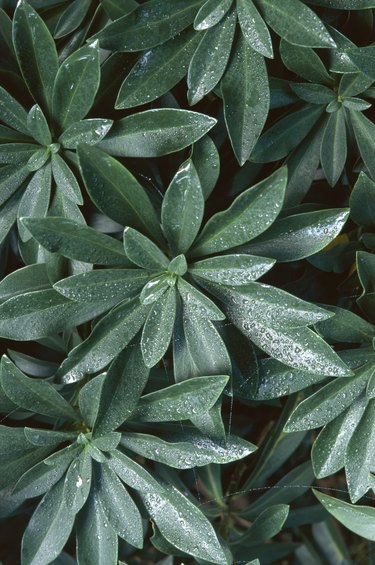Things You'll Need
Rake
10-10-10 granular, slow release fertilizer
Garden sprayer (optional)
Iron sulfate (optional)
Soil pH tester probe
Acidic granular fertilizer (optional)

True laurel (Laurus nobilis) and mountain laurel (Kalmia latifolia) both thrive in acidic soil environments. These shrubs typically are allowed to grow to between 4 and 8 feet tall, but if not pruned, they can develop into trees which reach heights of up to 40 feet. Fertilizing laurels is similar to fertilizing other acid-loving plants, such as azaleas and rhododendrons.
Step 1
Wait until the early spring, when no chance of frost remains, to fertilize the laurel shrubs as soon as you see new green color. Do not fertilize until the ground is complete thawed.
Video of the Day
Step 2
Rake the soil under the laurel to remove leaves, mulch and other debris from winter. If the material does not look moldy or diseased, mound it up for reuse. Otherwise, place the material into a trash can or a compost area.
Step 3
Open a bag of 10-10-10 time-release fertilizer and spread it over the soil under the laurel. Use 1 lb. of fertilizer granules for every 100 square feet of soil. Begin applying the fertilizer at least 2 inches from the trunk of the laurel to prevent burning.
Step 4
Rake the mulch back into positron to protect the shrub roots and to conserve soil moisture.
Step 5
Look closely at the leaves of the laurel on a regular basis to determine if any of the new ones are yellow, which indicates an iron deficiency. If yellow leaves occur, fill a garden sprayer with 1 gallon of water and 1 oz. of iron sulfate. Spray all foliage until saturated. Wait two weeks and spray the foliage again.
Tip
Check the pH level of the soil near the laurel twice per year by inserting a soil pH tester probe into the ground. If the pH level is higher than 6.0, it is not acidic enough. In these cases, apply a granular fertilizer formulated for azaleas or rhododendrons to adjust the soil pH.
Warning
Never add lime to the soil near laurel shrubs, since it alters the pH of the soil negatively.
Video of the Day